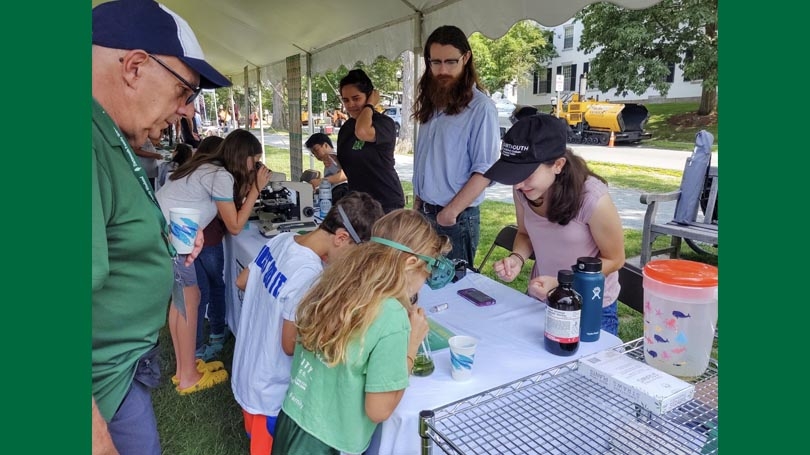
Students Sarah Valles, Lucas Dwiel and Hannah Margolis engage in hands-on STEM activities with visitors at Dartmouth's Summer Festival, one of the many events celebrating Dartmouth's 250th Anniversary (Photo: Brian Neumann)
Dartmouth students involved in Science, Technology, Engineering, and Math (STEM) outreach activities joined forces to bring hands-on science experiments to visitors at Dartmouth’s 250thSummer Festival. The event on Saturday, July 27, 2019 was part of the Sestercentennial Planning Committee activities.
A major goal of the celebration was to showcase all the resources Dartmouth has to offer the Upper Valley community. Cheryl Bascombe, co-chair of Dartmouth’s 250th anniversary celebration planning committee, said of the event “I was delighted to enjoy the company of our Upper Valley friends and neighbors and share with them the many ways in which they can engage with our campus and take advantage of the academic, cultural, and social activities Dartmouth offers. What a terrific way to celebrate 250 years with the whole community.”
The Outreach booth was hosted by students representing the Brain Bee, Science Day on Campus, and the Dartmouth ManyMentors chapter. Kidsand parents alike were invited to look through microscope slides, explore touch receptors on fingers, and see how the acidic carbon dioxide we breath out can change the color of a pH indicator. The experiments were organized and presented by Lucas Dwiel (Dept. of Neuroscience), Sarah Valles (MCB), Hannah Margolis (Biochem), and Avery Tishue (Physics) and provided hands-on ways to experience different STEM fields.
“From large events such as Science Pub in Lebanon, or Movies at the Nugget series in Hanover, to the many individual tailored activities including classroom visits or microscopy labs, Dartmouth offers a wealth of opportunities for the community to connect with researchers and research,” Amanda Skinner, Asst. Director of Outreach said. “Bringing these together at the Celebration was a great opportunity to raise awareness around Dartmouth’s accessibility.”
To explore neuroscience, Lucas helped kids and parents perform a marble experiment, in which a marble is first held between two fingers, and then held between the same two fingers when they’re crossed. This leads to an illusory perception that there are two marbles- not one- between your fingers as in everyday life the opposite sides of two fingers rarely touch the same object. “By crossing the fingers, our brains interpret the sensation of a single marble as two marbles,” explained Lucas. “This demonstration is a great way for kids, and adults, to literally get hands-on with neuroscience and experience directly how the mind can be fooled into misrepresenting reality.”
Hannah set up an experiment that allowed students to simultaneously explore pH and cellular respiration, the process through which the body consumes glucose and produces energy while also expelling carbon dioxide. Kids blew through straws into water with a color changing pH indicator, which went from green to yellow as the carbon dioxide mixed with the water to produce carbonic acid. The more active a participant was, the more carbon dioxide was produced, changing the colors more quickly and dramatically. “I love this experiment because there are so many directions you can take it,” Hannah said. “Not only are you introducing kids to pH, acids, and bases, you can use the experiment as a launching point to discuss energy production in our bodies or even ocean acidification.”
Kids and parents passing through the booth also had the opportunity to look through a microscope at slides such bone and ligament thin sections. Sarah walked participants through using the microscope and explained where the different components seen in the slides are found in the body. The microscopes were kindly loaned out by Ann Lavanway. The booth was packed with passing visitors for the entirely of the fair, providing an incredible chance to interact with a large number of children.
The Outreach Office and Dartmouth ManyMentors have many events year-round and are always looking for interested undergraduate and graduate volunteers with a passion for STEM. Learn more at academic-outreach.dartmouth.edu and dartmouthmanymentors.org.